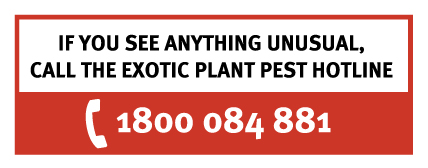




The European wheat stem sawfly (Cephus pygmeus) and the closely related wheat stem sawfly (Cephus cinctus) cause significant damage to winter cereals, such as; wheat, oats, cereal rye, barley, triticale, and also feed on other grasses such as wild oats, wheat grass, brome grasses and timothies.
Both species lay eggs in the stems of grasses. The larvae feed within the stems, filling them with frass. The larvae can cause lodging and significant yield losses.
The European wheat stem sawfly is an 8-10 mm long, black and yellow coloured wasp. There is also a very similar species called the wheat stem sawfly, which is 7-12 mm long and also black and yellow coloured.
Larvae feed within the stems of grasses, especially cereals. Infected stems are filled with frass (debris produced by the larvae) and are cleanly cut at the feeding site causing lodging.
Adults could be confused with several small wasps. Lodging can occur for various reasons. Any larvae found within lodged stems (especially cleanly cut stems) should be investigated further.
Overseas adults are present for only a few weeks each year so may be missed.
Cleanly cut, lodged stems should be inspected for signs of frass. Inspection of the stem below the break may reveal the presence of larvae.
This species can be spread as larvae within the stems of infected crops. Cereal straw, baled as hay or carried on machinery could potentially transport the pest over long distances. Adults are capable of flight for localised spread.
The European wheat stem sawfly occurs in Europe, parts of Asia and Africa, Canada and North America.
The wheat stem sawfly occurs in in western parts of the United States and Canada. There are also reports of this species occurring in Russia and Kazakhstan.
You can protect your farm from European wheat stem sawflies and wheat stem sawflies by checking your property frequently for the presence of new pests and by closely examining the cause of any lodging. Make sure you are familiar with the symptoms of common pests so you can tell if you see something different.
If you see anything unusual, call the Exotic Plant Pest Hotline on 1800 084 881.

The European wheat stem sawfly (Cephus pygmeus) and the closely related wheat stem sawfly (Cephus cinctus) cause significant damage to winter cereals, such as; wheat, oats, cereal rye, barley, triticale, and also feed on other grasses such as wild oats, wheat grass, brome grasses and timothies.
Both species lay eggs in the stems of grasses. The larvae feed within the stems, filling them with frass. The larvae can cause lodging and significant yield losses.
The European wheat stem sawfly is an 8-10 mm long, black and yellow coloured wasp. There is also a very similar species called the wheat stem sawfly, which is 7-12 mm long and also black and yellow coloured.
Larvae feed within the stems of grasses, especially cereals. Infected stems are filled with frass (debris produced by the larvae) and are cleanly cut at the feeding site causing lodging.
Adults could be confused with several small wasps. Lodging can occur for various reasons. Any larvae found within lodged stems (especially cleanly cut stems) should be investigated further.
Overseas adults are present for only a few weeks each year so may be missed.
Cleanly cut, lodged stems should be inspected for signs of frass. Inspection of the stem below the break may reveal the presence of larvae.
This species can be spread as larvae within the stems of infected crops. Cereal straw, baled as hay or carried on machinery could potentially transport the pest over long distances. Adults are capable of flight for localised spread.
The European wheat stem sawfly occurs in Europe, parts of Asia and Africa, Canada and North America.
The wheat stem sawfly occurs in in western parts of the United States and Canada. There are also reports of this species occurring in Russia and Kazakhstan.

You can protect your farm from European wheat stem sawflies and wheat stem sawflies by checking your property frequently for the presence of new pests and by closely examining the cause of any lodging. Make sure you are familiar with the symptoms of common pests so you can tell if you see something different.
If you see anything unusual, call the Exotic Plant Pest Hotline on 1800 084 881.